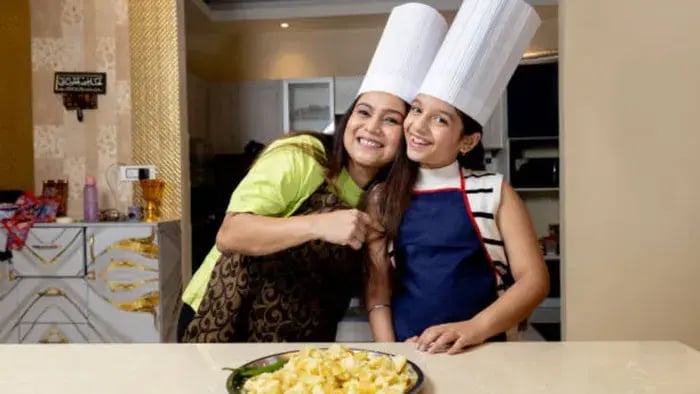- Guess the Ingredient
- Rainbow Plate Challenge
- Make a Face on the Plate
- Food Sorting Game
- Alphabet Food Hunt
- The 5-Senses Food Review
- Tiny Chef Time
- Yes or No Food Questions
- Name That Crunch
Introduction
Sometimes, mealtime with kids can feel a bit less exciting. Kids may not want to eat a dish, or it may be because of the same routine. But parents can make this time a bit more fun and creative with some food games. These games are a fun way to turn regular meals into exciting experiences that encourage better eating habits and build essential skills.

These games can be simple but effective, from guessing ingredients by taste or smell to naming the colours on the plate; these activities help kids become more mindful of their food. They also spark curiosity about textures, flavours and where food comes from. For fussy eaters, turning food into a game can reduce pressure and make mealtime something to look forward to.
Apart from being fun, food games also support development. They boost vocabulary, memory, focus and even introduce basic concepts like counting or matching. Whether it’s making a face out of veggies or playing “guess the fruit”, these small moments make a big difference in how kids connect with what they eat.
Adding a bit of fun to meals doesn’t take much; it just takes a playful spirit and a bit of imagination. With the right food games, mealtimes can be joyful opportunities to eat well, learn more, and bond as a family.
9 Fun Food Games for Kids That Make Mealtimes More Exciting and Educational

Mealtimes don’t have to be just about eating, they can be moments of learning, laughter, and togetherness. Adding playful food games to your child’s mealtime can help them enjoy what’s on their plate while also picking up useful skills like counting, identifying textures, or learning about healthy eating. These food games are simple to try and bring joy, curiosity, and fun to the table.
Guess the Ingredient
Wrap clothes around children's eyes and let them taste a small bite of food. Ask them to guess what it is based on flavour, texture, or smell. This will sharpen their senses and help them develop a food vocabulary while making them more open to trying new foods.
Rainbow Plate Challenge
Encourage your child to spot or build a meal with as many colours as possible—red tomatoes, green spinach, orange carrots, and more. This fun game teaches about food diversity, nutrition, and how different coloured foods support health in various ways.
Make a Face on the Plate
Give your child ingredients like cucumber slices, olives, noodles, or chapati pieces and ask them to create a funny face or picture on their plate. It sparks creativity, encourages trying new foods, and turns eating into a playful art project.
Food Sorting Game
Ask your child to sort into groups of mixed food items like dry fruits, pasta shapes, or chopped veggies. You can do this before mealtime, during prep, or while eating. This builds early classification skills and helps children notice details in everyday things.
Alphabet Food Hunt
Challenge your child to find food for each letter: A for apple, B for banana, and C for carrot. This game can be played verbally or with real food. It boosts memory, builds vocabulary, and makes even simple meals more interactive.
The 5-Senses Food Review
Let your child explore a bite of food using sight, touch, smell, taste, and sound (like the crunch of a carrot). Then, have them describe what they experience. This game improves language skills and helps children become mindful eaters.
Tiny Chef Time
Give your child a simple task like spreading butter, arranging salad, or filling their roti roll. When they help build their meal, they feel proud and more likely to enjoy it. It also teaches responsibility and basic kitchen skills.
Yes or No Food Questions
Think of a food item and have your child ask “yes” or “no” questions to figure it out: “Is it a fruit?” “Is it green?” This builds deduction skills and can be played while waiting for food to be served or during light meals.
Name That Crunch
Let your child listen to crunchy foods—like chips, apples, or toast—and guess what they are. This fun sensory game develops listening skills and adds a playful twist to snacks and side dishes.
Conclusion

Turning mealtimes into playful moments doesn’t just make eating easier; it also helps children explore food without pressure, learn more about what they’re eating, and stay curious. These games support emotional bonding, reduce fussiness, and create memories that last longer than the meal. All you need is a little imagination and laughter at the table.
Her love for storytelling began with reading her grandfather’s speeches, where Tarishi saw the power of words in creating lasting memories. Combining her passions for food and writing, she has turned her life into a fulfilling path of sharing stories that celebrate flavours and how food brings communities together.
The views expressed are that of the expert alone.
The information provided in this content is for informational purposes only and should not be considered a substitute for professional medical advice, diagnosis, or treatment. Always seek the advice of your physician or another qualified healthcare provider before making any significant changes to your diet, exercise, or medication routines.
















